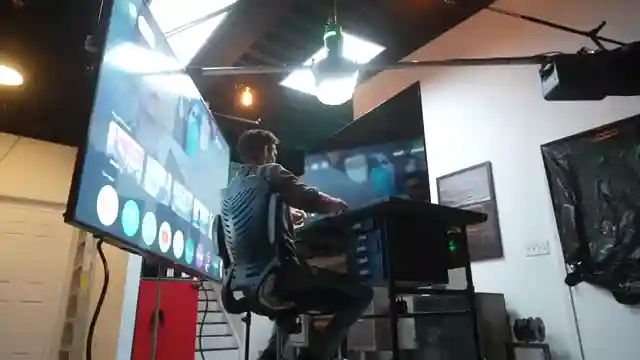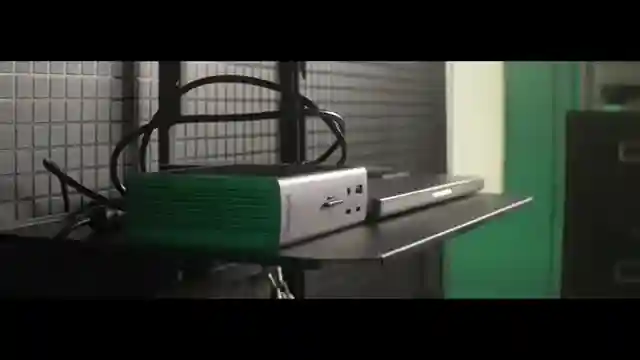Sony Bravia TV Integration: Innovating Virtual Production with MAKE. ART. NOW.

- Authors
- Published on
- Published on
On MAKE. ART. NOW., the team embarked on a daring experiment involving a massive Sony Bravia LED TV and a custom-built orbiting Production Studio. Sony dared them to integrate the TV into their filmmaking process, despite warnings of potential mishaps. The $7,000 TV boasted impressive features like a full array LED and HDMI ports supporting up to 120 htz, essential for virtual production. With the TV's sound-enhancing Tweeter Arrangement and high refresh rate, the team delved into testing its capabilities with Unreal Engine 5.4, facing challenges like wireless tethering to iPhones.
Undeterred by obstacles, the team forged ahead, constructing a bracket to secure the behemoth TV and powering it with a DJI Power Station. Through clever modifications and strategic counterbalancing, they managed to mount the TV on the orbit successfully. With a Sony zb1 camera in play, they shot a plate and tested the setup, ultimately achieving their ambitious goal. Despite initial doubts and technical hurdles, the team's perseverance and ingenuity prevailed, showcasing the potential of merging cutting-edge technology with traditional filmmaking techniques.
The team's journey on MAKE. ART. NOW. exemplified a fusion of innovation and practicality, pushing the boundaries of what's possible in the realm of filmmaking. By seamlessly integrating the Sony Bravia TV into their setup, they demonstrated the power of combining state-of-the-art equipment with creative solutions. Through meticulous planning, skillful modifications, and relentless determination, they transformed a seemingly impossible vision into a tangible reality. This daring experiment not only showcased the team's technical prowess but also highlighted the endless possibilities when imagination meets cutting-edge technology in the world of filmmaking.

Image copyright Youtube

Image copyright Youtube

Image copyright Youtube

Image copyright Youtube
Watch I built a 360 degree Virtual Production set from a Costco TV. on Youtube
Viewer Reactions for I built a 360 degree Virtual Production set from a Costco TV.
Comment on the creativity and effort put into the video
Mention of using a large TV for unique purposes
Praise for the storytelling and craftsmanship in the video
Comparison to how "The Mandalorian" is shot
Suggestion to try an ultra short focus projector for a giant screen
Comment on the DIY VR setup
Mention of using DMX lighting connected to Unreal Engine for a better effect
Appreciation for the concept working
Idea of using a circular track for support and balance
Humorous comments about the video and the creator
Related Articles

NAB 2025 Camera Tech Innovations: Cammonic, Viltrox, Sony
Discover the latest innovations in camera technology from NAB 2025. Highlights include Cammonic's K9 lav kit, Viltrox's DL lens kit for the Ronin 4D, and Sony's compact sensor body for the Venice 2. Exciting developments promise enhanced filming experiences for creators.

Mel Gibson's 'Flight Risk': Virtual Cinematography with Sony Venice & LED Sets
Explore Mel Gibson's virtual cinematography in "Flight Risk," shot using Sony Venice and DJI Ronin 4D. Learn about innovative LED volume sets and advanced lighting techniques for a truly immersive viewing experience. Gibson's film sets a new standard in cinematic storytelling.

Mastering Aerial Cinematography: Inspire 3 Drone Unleashed
Unleash the power of the Inspire 3 drone in this MAKE. ART. NOW. episode. Featuring 8.1k ProRes RAW, 15 stops of dynamic range, and innovative time code sync for unparalleled cinematography. Explore the top-tier features and accessories that make this drone a game-changer in aerial filmmaking.

DJI Inspire 3 Review: Unleashing Superior Dynamic Range and Performance
The DJI Inspire 3 excels in dynamic range, resolution, and color fidelity, outperforming traditional cameras. Gerald undone tests its capabilities, praising it as a flying A1 camera. Discover the groundbreaking features of the Inspire 3 in this in-depth review.
